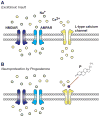Progesterone inhibition of neuronal calcium signaling underlies aspects of progesterone-mediated neuroprotection
- PMID: 22101209
- PMCID: PMC3303940
- DOI: 10.1016/j.jsbmb.2011.11.002
Progesterone inhibition of neuronal calcium signaling underlies aspects of progesterone-mediated neuroprotection
Abstract
Progesterone is being utilized as a therapeutic means to ameliorate neuron loss and cognitive dysfunction following traumatic brain injury. Although there have been numerous attempts to determine the means by which progesterone exerts neuroprotective effects, studies describing the underlying molecular mechanisms are lacking. What has become clear, however, is the notion that progesterone can thwart several physiological processes that are detrimental to neuron function and survival, including inflammation, edema, demyelination and excitotoxicity. One clue regarding the means by which progesterone has restorative value comes from the notion that these aforementioned biological processes all share the common theme of eliciting pronounced increases in intracellular calcium. Thus, we propose the hypothesis that progesterone regulation of calcium signaling underlies its ability to mitigate these cellular insults, ultimately leading to neuroprotection. Further, we describe recent findings that indicate neuroprotection is achieved via progesterone block of voltage-gated calcium channels, although additional outcomes may arise from blockade of various other ion channels and neurotransmitter receptors. This article is part of a Special Issue entitled 'Neurosteroids'.
Copyright © 2011 Elsevier Ltd. All rights reserved.
Figures

Similar articles
-
Progesterone inhibition of voltage-gated calcium channels is a potential neuroprotective mechanism against excitotoxicity.Steroids. 2011 Aug;76(9):845-55. doi: 10.1016/j.steroids.2011.02.013. Epub 2011 Mar 1. Steroids. 2011. PMID: 21371490 Free PMC article.
-
Progesterone neuroprotection in traumatic CNS injury and motoneuron degeneration.Front Neuroendocrinol. 2009 Jul;30(2):173-87. doi: 10.1016/j.yfrne.2009.03.001. Epub 2009 Mar 24. Front Neuroendocrinol. 2009. PMID: 19318112 Review.
-
[Cerebral ischemia-hypoxia and biophysical mechanisms of neurodegeneration and neuroprotection effects].Fiziol Zh (1994). 2003;49(2):7-12. Fiziol Zh (1994). 2003. PMID: 12945108 Review. Ukrainian.
-
Carvacrol attenuates traumatic neuronal injury through store-operated Ca(2+) entry-independent regulation of intracellular Ca(2+) homeostasis.Neurochem Int. 2015 Nov;90:107-13. doi: 10.1016/j.neuint.2015.07.020. Epub 2015 Jul 26. Neurochem Int. 2015. PMID: 26220904
-
Neuroprotective effects of selective N-type VGCC blockade on stretch-injury-induced calcium dynamics in cortical neurons.J Neurotrauma. 2010 Jan;27(1):175-87. doi: 10.1089/neu.2009.1003. J Neurotrauma. 2010. PMID: 19772476 Free PMC article.
Cited by
-
Progesterone distribution in the trigeminal system and its role to modulate sensory neurotransmission: influence of sex.J Headache Pain. 2023 Nov 14;24(1):154. doi: 10.1186/s10194-023-01687-x. J Headache Pain. 2023. PMID: 37957603 Free PMC article.
-
Steroid Sulfation in Neurodegenerative Diseases.Front Mol Biosci. 2022 Feb 23;9:839887. doi: 10.3389/fmolb.2022.839887. eCollection 2022. Front Mol Biosci. 2022. PMID: 35281259 Free PMC article. Review.
-
Modular Hub Genes in DNA Microarray Suggest Potential Signaling Pathway Interconnectivity in Various Glioma Grades.Biology (Basel). 2024 Mar 23;13(4):206. doi: 10.3390/biology13040206. Biology (Basel). 2024. PMID: 38666818 Free PMC article.
-
Effects of Female Sex Steroids Administration on Pathophysiologic Mechanisms in Traumatic Brain Injury.Transl Stroke Res. 2018 Aug;9(4):393-416. doi: 10.1007/s12975-017-0588-5. Epub 2017 Nov 19. Transl Stroke Res. 2018. PMID: 29151229 Review.
-
Neurosteroids and Seizure Activity.Front Endocrinol (Lausanne). 2020 Sep 30;11:541802. doi: 10.3389/fendo.2020.541802. eCollection 2020. Front Endocrinol (Lausanne). 2020. PMID: 33117274 Free PMC article.
References
-
- Betz AL, Coester HC. Effect of steroids on edema and sodium uptake of the brain during focal ischemia in rats. Stroke. 1990;21:1199–204. - PubMed
-
- Jiang N, Chopp M, Stein D, Feit H. Progesterone is neuroprotective after transient middle cerebral artery occlusion in male rats. Brain Res. 1996;735:101–7. - PubMed
-
- Murphy SJ, Littleton-Kearney MT, Hurn PD. Progesterone administration during reperfusion, but not preischemia alone, reduces injury in ovariectomized rats. J Cereb Blood Flow Metab. 2002;22:1181–8. - PubMed
-
- Morali G, Letechipia-Vallejo G, Lopez-Loeza E, Montes P, Hernandez-Morales L, Cervantes M. Post-ischemic administration of progesterone in rats exerts neuroprotective effects on the hippocampus. Neurosci Lett. 2005;382:286–90. - PubMed
-
- Gibson CL, Murphy SP. Progesterone enhances functional recovery after middle cerebral artery occlusion in male mice. Journal of Cerebral Blood Flow & Metabolism. 2004;24:805–13. - PubMed
Publication types
MeSH terms
Substances
Grants and funding
LinkOut - more resources
Full Text Sources
Other Literature Sources

